On the final day of EFSP's little Ernst Lubitsch festival, a post on his very first talkie, the Anerican musical comedy The Love Parade (1929), starring Maurice Chevalier and Jeanette MacDonald. Lubitsch's sound debut was a magnificent success with 'the Lubitsch touch' intact. He would remain Hollywood's most elegant and sophisticated director for another decade.
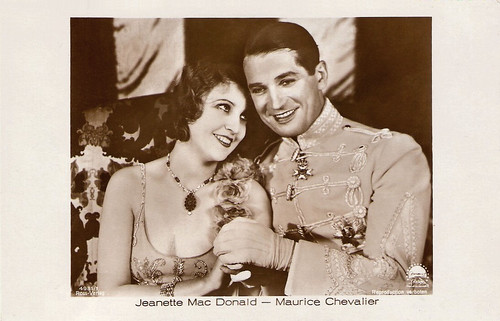
German postcard by Ross Verlag, no. 4981/1, 1929-1930. Photo: Paramount. Publicity still for The Love Parade (Ernst Lubitsch, 1929) with Maurice Chevalier and Jeanette MacDonald.

French postcard by Cinémagazine-Edition, Paris, no. 793. Photo: Paramount. Publicity still for The Love Parade (Ernst Lubitsch, 1929).
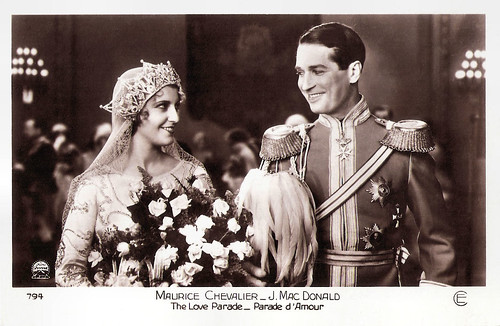
French postcard by Cinémagazine Edition, Paris, no. 794. Photo: Paramount. Publicity still for The Love Parade (Ernst Lubitsch, 1929).

French postcard by Cinémagazine-Edition (CE), Paris, no. 795. Photo: Paramount. Publicity still for The Love Parade (Ernst Lubitsch, 1929) with Lupino Lane and Lillian Roth.
The stars in Ernst Lubitsch's teasing gem The Love Parade (1929) are Maurice Chevalier and Jeanette MacDonald in her film debut. Maurice Chevalier had thought that he would never be capable of acting as a Royal courtier, and had to be persuaded by Lubitsch.
Chevalier plays Count Alfred, military attaché to the Embassy in Paris of mythical Sylvania. He is ordered back to Sylvania to report to Queen Louise (Jeanette MacDonald) for a reprimand following a string of scandals, including an affair with the ambassador's wife.
In the meantime Queen Louise, ruler of Sylvania in her own right, is royally fed-up with her subjects' preoccupation with whom she will marry. Intrigued rather than offended by Count Alfred's dossier, Queen Louise invites him to dinner.
Their romance progresses to the point of marriage. Despite his qualms, Alfred agrees to obey the Queen for love of Louise. However Alfred finds his new life unsatisfying and his position as Queen's Consort without purpose, and the marriage soon runs into difficulties.
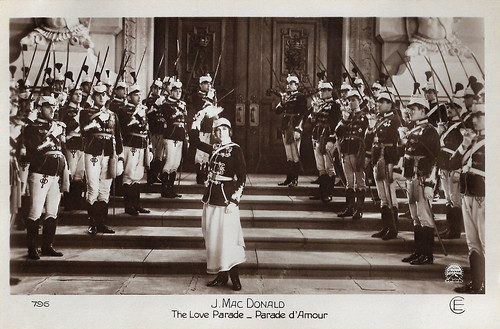
French postcard by Cinémagazine-Edition, no. 796. Photo: Paramount. Publicity still for The Love Parade (Ernst Lubitsch, 1929).
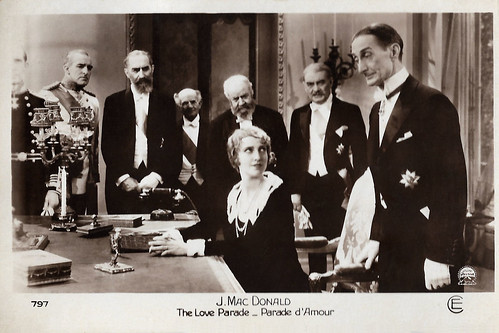
French postcard by Cinémagazine-Edition, no. 797. Photo: Paramount. Publicity still for The Love Parade (Ernst Lubitsch, 1929) with Jeanette MacDonald and Edgar Norton.
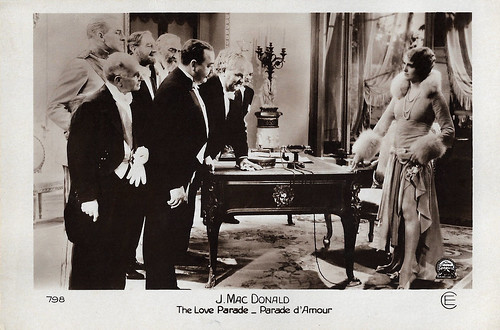
French postcard by Cinémagazine-Edition, no. 798. Photo: Paramount. Publicity still for The Love Parade (Ernst Lubitsch, 1929).
The Love Parade is notable for being both the film debut of Jeanette MacDonald and the first 'talkie' made by Ernst Lubitsch. Although it was his first sound film, Lubitsch already displayed a mastery of the technical requirements of the day. In one scene, two couples sing the same song alternately.
To do this with the available technology, Lubitsch had two sets built, with an off-camera orchestra between them, and directed both scenes simultaneously. This enabled him to cut back and forth from one scene to the other in editing, something unheard of at the time.
The screenplay by Guy Bolton and Ernest Vajda was adapted from the French play Le Prince Consort, written by Jules Chancel and Leon Xanrof. The play had previously been adapted for Broadway in 1905 by William Boosey and Cosmo Gordon Lennox.
The Love Parade also featured a great supporting cast including British variety star Lupino Lane as Chevalier's orderly Jacques, Lillian Roth as MacDonald's maid Lulu, Eugene Pallette as the Minister of War and Edgar Norton as Master of Ceremonies.
The picture was also released in a French-language version called Parade d'amour. The Love Parade was nominated for six Academy Awards, including Best Picture, Best Actor (Chevalier) and Best Director. This huge box-office hit appeared just after the Wall Street crash, and did much to save the fortunes of Paramount.
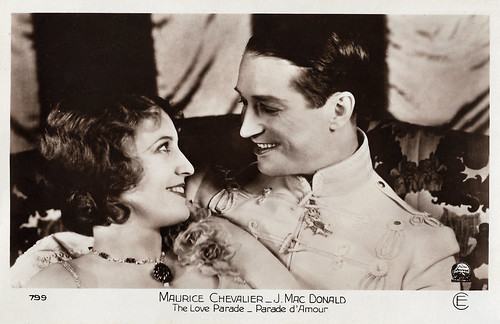
French postcard by Cinémagazine-Edition, no. 799. Photo: Paramount. Publicity still for The Love Parade (Ernst Lubitsch, 1929).
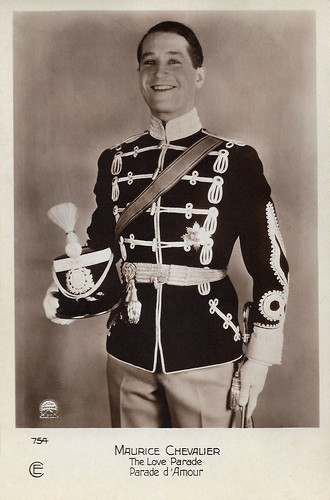
French postcard by Cinémagazine-Edition, no. 754. Photo: Paramount. Publicity still for The Love Parade (Ernst Lubitsch, 1929).

Belgian postcard by Thill, Bruxelles, no. 794. Photo: Paramount. Publicity still for Parade d'amour/The Love Parade (Ernst Lubitsch, 1929).
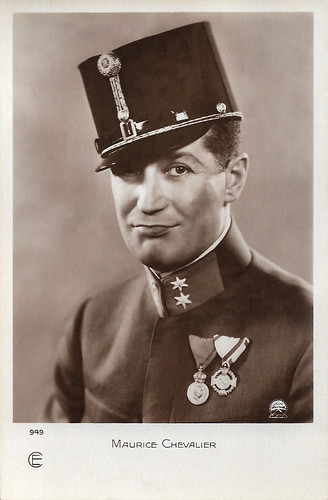
French postcard by Cinémagazine-Edition, Paris, no. 949. Photo: Paramount. Publicity still for The Love Parade (Ernst Lubitsch, 1929).
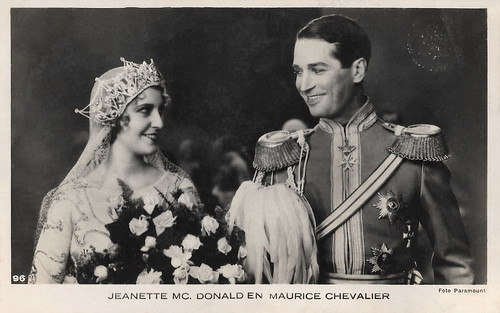
Dutch postcard, no. 96. Photo: Paramount. Publicity still for The Love Parade (Ernst Lubitsch, 1929).
Sources: Wikipedia and IMDb

German postcard by Ross Verlag, no. 4981/1, 1929-1930. Photo: Paramount. Publicity still for The Love Parade (Ernst Lubitsch, 1929) with Maurice Chevalier and Jeanette MacDonald.

French postcard by Cinémagazine-Edition, Paris, no. 793. Photo: Paramount. Publicity still for The Love Parade (Ernst Lubitsch, 1929).

French postcard by Cinémagazine Edition, Paris, no. 794. Photo: Paramount. Publicity still for The Love Parade (Ernst Lubitsch, 1929).

French postcard by Cinémagazine-Edition (CE), Paris, no. 795. Photo: Paramount. Publicity still for The Love Parade (Ernst Lubitsch, 1929) with Lupino Lane and Lillian Roth.
Teasing Gem
The stars in Ernst Lubitsch's teasing gem The Love Parade (1929) are Maurice Chevalier and Jeanette MacDonald in her film debut. Maurice Chevalier had thought that he would never be capable of acting as a Royal courtier, and had to be persuaded by Lubitsch.
Chevalier plays Count Alfred, military attaché to the Embassy in Paris of mythical Sylvania. He is ordered back to Sylvania to report to Queen Louise (Jeanette MacDonald) for a reprimand following a string of scandals, including an affair with the ambassador's wife.
In the meantime Queen Louise, ruler of Sylvania in her own right, is royally fed-up with her subjects' preoccupation with whom she will marry. Intrigued rather than offended by Count Alfred's dossier, Queen Louise invites him to dinner.
Their romance progresses to the point of marriage. Despite his qualms, Alfred agrees to obey the Queen for love of Louise. However Alfred finds his new life unsatisfying and his position as Queen's Consort without purpose, and the marriage soon runs into difficulties.

French postcard by Cinémagazine-Edition, no. 796. Photo: Paramount. Publicity still for The Love Parade (Ernst Lubitsch, 1929).

French postcard by Cinémagazine-Edition, no. 797. Photo: Paramount. Publicity still for The Love Parade (Ernst Lubitsch, 1929) with Jeanette MacDonald and Edgar Norton.

French postcard by Cinémagazine-Edition, no. 798. Photo: Paramount. Publicity still for The Love Parade (Ernst Lubitsch, 1929).
Something unheard of at the time
The Love Parade is notable for being both the film debut of Jeanette MacDonald and the first 'talkie' made by Ernst Lubitsch. Although it was his first sound film, Lubitsch already displayed a mastery of the technical requirements of the day. In one scene, two couples sing the same song alternately.
To do this with the available technology, Lubitsch had two sets built, with an off-camera orchestra between them, and directed both scenes simultaneously. This enabled him to cut back and forth from one scene to the other in editing, something unheard of at the time.
The screenplay by Guy Bolton and Ernest Vajda was adapted from the French play Le Prince Consort, written by Jules Chancel and Leon Xanrof. The play had previously been adapted for Broadway in 1905 by William Boosey and Cosmo Gordon Lennox.
The Love Parade also featured a great supporting cast including British variety star Lupino Lane as Chevalier's orderly Jacques, Lillian Roth as MacDonald's maid Lulu, Eugene Pallette as the Minister of War and Edgar Norton as Master of Ceremonies.
The picture was also released in a French-language version called Parade d'amour. The Love Parade was nominated for six Academy Awards, including Best Picture, Best Actor (Chevalier) and Best Director. This huge box-office hit appeared just after the Wall Street crash, and did much to save the fortunes of Paramount.

French postcard by Cinémagazine-Edition, no. 799. Photo: Paramount. Publicity still for The Love Parade (Ernst Lubitsch, 1929).

French postcard by Cinémagazine-Edition, no. 754. Photo: Paramount. Publicity still for The Love Parade (Ernst Lubitsch, 1929).

Belgian postcard by Thill, Bruxelles, no. 794. Photo: Paramount. Publicity still for Parade d'amour/The Love Parade (Ernst Lubitsch, 1929).

French postcard by Cinémagazine-Edition, Paris, no. 949. Photo: Paramount. Publicity still for The Love Parade (Ernst Lubitsch, 1929).

Dutch postcard, no. 96. Photo: Paramount. Publicity still for The Love Parade (Ernst Lubitsch, 1929).
Sources: Wikipedia and IMDb
No comments:
Post a Comment